Marlon Brando facts for kids
Quick facts for kids
Marlon Brando
|
|
|---|---|
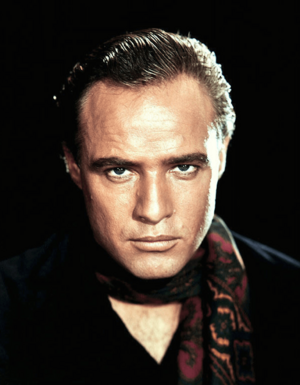
Brando in One-Eyed Jacks (1961)
|
|
| Born |
Marlon Brando Jr.
April 3, 1924 Omaha, Nebraska, U.S.
|
| Died | July 1, 2004 (aged 80) Los Angeles, California, U.S.
|
| Occupation |
|
| Years active | 1944–2004 |
|
Works
|
Full list |
| Spouse(s) |
Tarita Teriipaia
(m. 1962; div. 1972) |
| Children | 11 (8 biological, 3 adopted); including Christian and Cheyenne |
| Relatives | Jocelyn Brando (sister) D. A. Pennebaker (cousin) |
| Awards | Full list |
| Signature | |
Marlon Brando Jr. (April 3, 1924 – July 1, 2004) was a famous American actor. Many people think he was one of the most important actors of the 20th century. Over his six-decade career, he won many awards, including two Academy Awards, two Golden Globe Awards, and three British Academy Film Awards.
Brando was also an activist who supported important causes. He was a strong voice for the civil rights movement and for Native American rights. In the 1940s, he studied acting with Stella Adler. He is known for helping to bring the Stanislavski system of acting, also known as method acting, to a wider audience. This style of acting helps actors create very realistic characters.
Contents
Early Life and Education
Marlon Brando was born in Omaha, Nebraska, on April 3, 1924. His father, Marlon Brando Sr., worked with chemicals, and his mother, Dorothy Julia Pennebaker, was involved in theater. Marlon had two older sisters, Jocelyn and Frances. His family background was mostly German, Dutch, English, and Irish.
Around 1930, his family moved to Evanston, Illinois. When Marlon was 11, his parents separated, and his mother took the children to Santa Ana, California. They later got back together and moved to a farm in Libertyville, Illinois. From 1939 to 1941, Marlon worked as an usher at the local movie theater.
As a child, Marlon, whose nickname was "Bud," was very good at imitating people. He could copy how other children acted and use it in his dramatic play. He became best friends with a neighborhood boy named Wally Cox. His childhood friend, George Englund, remembered Marlon imitating farm animals to entertain his mother.
Marlon's sister Jocelyn was the first to become an actor, studying in New York City. Marlon was held back a year in school and later got expelled from Libertyville High School for riding his motorcycle through the hallways.
He was then sent to Shattuck Military Academy in Minnesota, where his father had also studied. Marlon did well in theater there. In his last year (1943), he was put on probation for being disobedient. He was caught sneaking out of his room and was expelled. He decided not to return to high school. Marlon worked as a ditch-digger during a summer. He tried to join the Army, but a football injury made him unable to serve.
Becoming an Actor in New York
Marlon decided to follow his sisters to New York. He studied acting at the American Theatre Wing Professional School. His sister Jocelyn recalled that he enjoyed a school play and decided that acting was the only thing he truly liked. George Englund said that Marlon found a place where he was accepted and praised for the first time in his life.
Brando was a dedicated student of Stella Adler, who taught him the Stanislavski system. This method helps actors understand their characters deeply, both inside and out. Brando was known for his realistic acting style. Adler once told a story about teaching a class to act like chickens during a pretend nuclear bomb attack. Most students ran around, but Brando calmly sat and pretended to lay an egg. When asked why, he said, "I'm a chicken—what do I know about bombs?" Even though he was called a "method actor," Brando himself didn't always agree with that label.
Brando was one of the first actors to bring a very natural style to film acting. He would often talk to the crew and other actors about their weekend, even after the director called "action." He would only start his lines when he felt he could deliver them as naturally as a real conversation. This approach made his performances feel very real.
Career Highlights
Early Roles: 1944–1951
Brando first used his acting skills in summer plays in Sayville, New York. He sometimes behaved in ways that got him removed from plays, but he was soon discovered in a local production. In 1944, he made his Broadway debut in I Remember Mama.
He was voted "Most Promising Young Actor" for his role in Truckline Café. In 1946, he appeared on Broadway in A Flag is Born and also worked with famous actress Katharine Cornell in Candida and Antigone.
In 1945, Brando's agent suggested he co-star with Tallulah Bankhead in The Eagle Has Two Heads. Bankhead saw his potential, even though she didn't like his method acting style. They often disagreed during rehearsals. Brando sometimes mumbled his lines, but when challenged, he would act with great power. A cast member remembered him saying, "They don't think you can act unless you can yell."
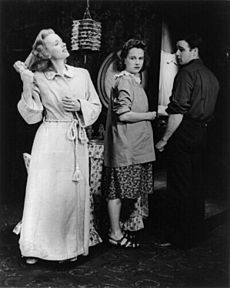
In 1947, Brando played Stanley Kowalski in Tennessee Williams's play A Streetcar Named Desire, directed by Elia Kazan. This role made him very famous.
Brando's first film role was in The Men (1950), where he played a veteran who was paralyzed. To prepare, he spent a month in a hospital bed. Critics praised his performance, saying he was "vividly real, dynamic and sensitive."
Early in his career, Brando started using cue cards instead of memorizing all his lines. He felt this made his acting more natural and spontaneous, rather than sounding like he was just reciting a speech. Some people thought he did this out of laziness, but Brando believed it helped his performances.
Rise to Stardom: 1951–1954
Brando brought his famous role as Stanley Kowalski to the big screen in A Streetcar Named Desire (1951). This role is still considered one of his best and earned him his first Academy Award nomination for Best Actor.
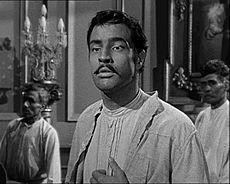
The next year, he was nominated again for Viva Zapata! (1952). This film told a fictional story about the life of Emiliano Zapata, a Mexican revolutionary. Brando secretly visited the town where Zapata lived to study how people spoke and moved. Critics loved his performance.
Brando's next film, Julius Caesar (1953), also received great reviews. He played Mark Antony and delivered a powerful performance, especially during the famous "Friends, Romans, countrymen..." speech. Even famous British actor John Gielgud was impressed.
In 1953, Brando also starred in The Wild One, riding his own motorcycle. The film was about rowdy motorcycle gangs. It was criticized at the time for its violence, but it inspired teen rebellion and made Brando a role model for the new rock-and-roll generation, including future stars like James Dean and Elvis Presley. After the movie, sales of leather jackets and motorcycles increased a lot.
On the Waterfront
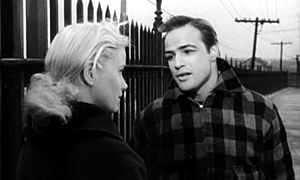
In 1954, Brando starred in On the Waterfront, a crime drama film about violence and corruption among longshoremen (dock workers). The film was directed by Elia Kazan. Brando played Terry Malloy, an Irish-American stevedore.
Brando won an Oscar for his role in On the Waterfront. His performance was highly praised. For the famous scene where Terry says, "I coulda been a contender," Brando insisted on changing the script to make it more realistic.
When it was released, On the Waterfront received excellent reviews and was a big success. Film critic Roger Ebert said that Brando and Kazan changed acting in American films forever. Brando himself was often humble about his performances. After he won the Academy Award, the statue was stolen but later found.
Box Office Successes and Directing: 1954–1959
After On the Waterfront, Brando remained a very popular actor. He played Napoleon in the 1954 film Désirée. He later said he didn't like the script and put little effort into the role.
Brando and co-star Jean Simmons also appeared together in the musical film Guys and Dolls (1955). This was Brando's only musical role. The film made a lot of money, though critics had mixed feelings.
In The Teahouse of the August Moon (1956), Brando played a Japanese interpreter. In Sayonara (1957), he played a United States Air Force officer. Both films had social messages. Brando even started his own production company, Pennebaker, named after his mother, to make films that would "improve the world."
In 1958, Brando appeared in The Young Lions, where he dyed his hair blonde and tried a German accent. The film was based on a novel and his portrayal of the character Christian Diestl was notable for its time.
One-Eyed Jacks and Mutiny on the Bounty
In 1961, Brando directed his first film, the western One-Eyed Jacks. He also starred as the main character, Rio. The film went over budget because Brando took a long time with multiple takes and exploring characters. The studio eventually took over the editing. Brando later said the studio changed his version of the story.
Brando's next film was the 1962 remake of Mutiny on the Bounty, filmed in Tahiti. There were reports that Brando caused many delays during the production. The film almost caused financial trouble for the studio. Because of this, studios became worried about Brando's reputation for being difficult. Critics also started to notice his weight changes.
Later Career: 1963–1971
During this time, Brando became less interested in acting for art and more for money. He signed a five-picture deal with Universal Studios. The first film was The Ugly American (1963), which was well-received but didn't make much money.
Other films he made during this period, like Bedtime Story (1964) and A Countess from Hong Kong (1967), were not very successful. Brando was excited to work with director Charlie Chaplin on Countess, but the experience was not what he expected.
The Godfather and Last Tango in Paris
By the 1970s, Brando was not considered a reliable actor for big movies. His performance as Vito Corleone, the "Don," in The Godfather (1972) changed everything. This role brought him back to the top and won him his second Best Actor Oscar.
Brando's performance was highly praised by critics. He said he wanted to play a gangster who was respected, not just a bad guy. Brando won the Academy Award for Best Actor for his role, but he famously refused to accept it. He sent actress Sacheen Littlefeather to the ceremony in his place. She explained that Brando was rejecting the award to protest "the treatment of American Indians today by the film industry." This happened during the Wounded Knee Occupation of 1973, which was a protest by Native Americans.
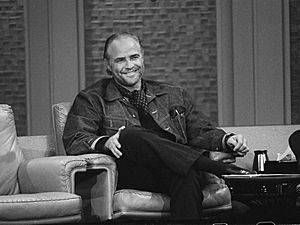
After The Godfather, Brando starred in Bernardo Bertolucci's 1972 film Last Tango in Paris. This movie was also a hit and earned him another Best Actor nomination.
Late 1970s
In 1976, Brando appeared in The Missouri Breaks with his friend Jack Nicholson. Critics were not kind to the film.
Brando played Superman's father Jor-El in the 1978 film Superman. He agreed to the role only if he was paid a large sum for a small part and didn't have to memorize his lines. He was paid $3.7 million for two weeks of work. He also filmed scenes for Superman II, but they were not used because he and the producers disagreed on his payment.
In 1979, he made a rare television appearance in the miniseries Roots: The Next Generations, playing George Lincoln Rockwell. He won an Emmy Award for his performance.
Brando starred as Colonel Walter E. Kurtz in Francis Ford Coppola's Vietnam War film Apocalypse Now (1979). He was paid $1 million a week for three weeks of work. The film's production was long and difficult. Brando arrived on set overweight, and he and Coppola spent days discussing his character. His whispering of Kurtz's final words, "The horror! The horror!", became very famous. Brando earned about $9 million for this role.
Final Films
After The Formula (1980), Brando announced he was retiring from acting. However, he returned in 1989 in A Dry White Season, an anti-apartheid novel adaptation. Brando received praise for his performance and was nominated for an Academy Award.
Brando also received good reviews for his role as Carmine Sabatini in The Freshman (1990). He starred with his friend Johnny Depp in the successful film Don Juan DeMarco (1995).
Some of his later films, like Christopher Columbus: The Discovery (1992) and The Island of Dr. Moreau (1996), received very bad reviews. However, his last completed film, The Score (2001), was generally well-received. In this film, he starred with Robert De Niro.
After Brando's death, a novel he had worked on, Fan-Tan, was released in 2005.
Final Years and Death
Brando gained a lot of weight in the 1970s and by the 1990s, he weighed over 300 pounds. He also suffered from Type 2 diabetes. He had a reputation for being difficult on film sets, sometimes not memorizing his lines or making unusual demands.
Marlon Brando died on July 1, 2004, at the UCLA Medical Center. He passed away due to respiratory failure from pulmonary fibrosis and congestive heart failure.
Brando was cremated. His ashes were mixed with those of his good friend Wally Cox and scattered partly in Tahiti and partly in Death Valley. In 2007, a documentary about Brando called Brando: The Documentary was released.
Personal Life
Brando had a complex personal life and was a father to at least 11 children, three of whom were adopted.
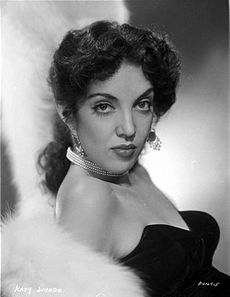
He married actress Anna Kashfi in 1957. They had a son, Christian Brando, in 1958, and divorced in 1959.
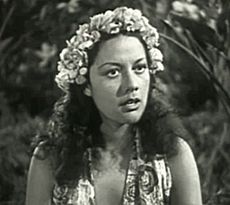
In 1960, Brando married actress Movita Castaneda. They had two children: Miko Castaneda Brando (born 1961) and Rebecca Brando (born 1966). Their marriage was later ended in 1968.
French actress Tarita Teriipaia, who acted with Brando in Mutiny on the Bounty, became his third wife on August 10, 1962. She was 18 years younger than him. Because she spoke French, Brando became fluent in the language. They had two children: Simon Teihotu Brando (born 1963) and Tarita Cheyenne Brando (1970–1995). Brando also adopted Teriipaia's daughter, Maimiti Brando (born 1977), and niece, Raiatua Brando (born 1982). They divorced in 1972.
Brando had three children with his housekeeper Maria Cristina Ruiz: Ninna Priscilla Brando (born 1989), Myles Jonathan Brando (born 1992), and Timothy Gahan Brando (born 1994). He also adopted Petra Brando-Corval (born 1972), the daughter of his assistant.
Political Activism
Brando was very involved in political causes. In August 1963, he participated in the March on Washington alongside other famous people like Harry Belafonte and Sidney Poitier. He also joined the Freedom Rides, which challenged segregation.

After the 1968 assassination of Martin Luther King Jr., Brando strongly committed to continuing King's work. He even stepped out of a major film role to focus on the civil rights movement. He said he wanted to understand what it meant to be Black in America. Actor Martin Sheen recalled seeing Brando walking through Harlem with Mayor Lindsay after King's death, calling it "one of the most incredible acts of courage."
Brando's support for civil rights began earlier. In the early 1960s, he donated thousands of dollars to civil rights organizations. In 1964, he was arrested at a "fish-in" protest to support Native American fishing rights in Puget Sound. He also supported films that addressed human rights issues, like Sayonara (about interracial romance) and The Ugly American (about U.S. officials' behavior abroad).

Brando was a strong supporter of Native American rights and the American Indian Movement. At the 1973 Academy Awards ceremony, he refused his Oscar for The Godfather. He sent Sacheen Littlefeather, who appeared in traditional Apache clothing, to explain that he would not accept the award due to the "poor treatment of Native Americans in the film industry." This event drew worldwide attention to Native American issues.
Brando also spoke out against apartheid in South Africa. In 1964, he wanted his films to be boycotted there to prevent them from being shown to segregated audiences. In 1975, he protested American investments in South Africa and called for the release of Nelson Mandela. In 1989, he starred in A Dry White Season, a film about apartheid.
Legacy
Marlon Brando is considered one of the most respected actors of his time. The American Film Institute listed him as the fourth greatest male star whose career began before or during 1950. He was known for his memorable performances and strong presence on screen. He helped make "method acting" popular and is seen as one of the greatest actors of the 20th century.
Cultural Influence

Marlon Brando is a cultural icon whose influence continues today. His rise to fame in the 1950s had a big impact on American culture.
His role as Johnny Strabler in The Wild One became a lasting image of rebellion. It inspired fashion trends like the motorcycle jacket, tilted cap, jeans, and sunglasses. Johnny's haircut even led to a craze for sideburns, copied by James Dean and Elvis Presley. The famous line "I coulda been a contender" from On the Waterfront has become a well-known phrase in American culture.
Brando admired actors like Spencer Tracy, John Barrymore, and James Cagney. He also showed respect for later actors such as Sean Penn, Jack Nicholson, Johnny Depp, and Daniel Day-Lewis.
Filmography
Awards and Honors
Brando was named the fourth greatest male star by the American Film Institute. TIME magazine also included him in their list of "The Most Important People of the Century." Variety magazine named him one of the top 10 "Icons of the Century."
See also
 In Spanish: Marlon Brando para niños
In Spanish: Marlon Brando para niños
- List of oldest and youngest Academy Award winners and nominees
- List of actors with Academy Award nominations
- List of actors with two or more Academy Award nominations in acting categories
- List of actors with two or more Academy Awards in acting categories
- List of LGBT Academy Award winners and nominees







